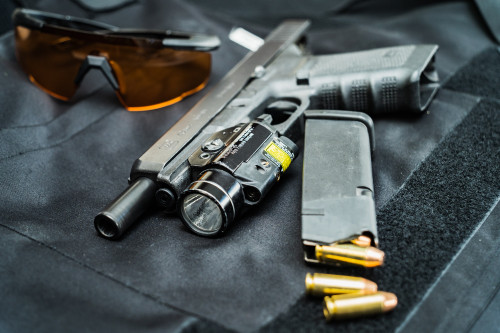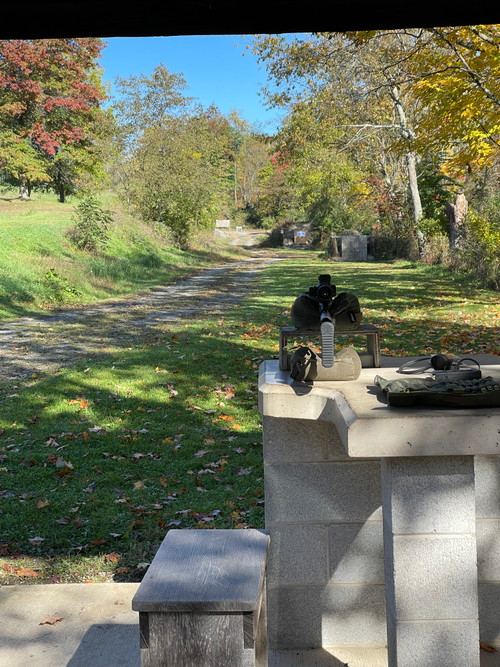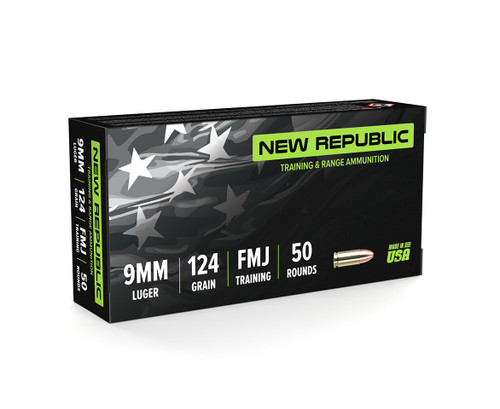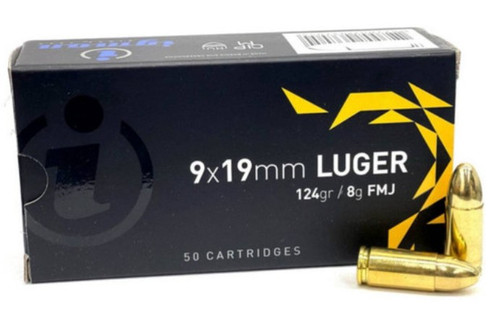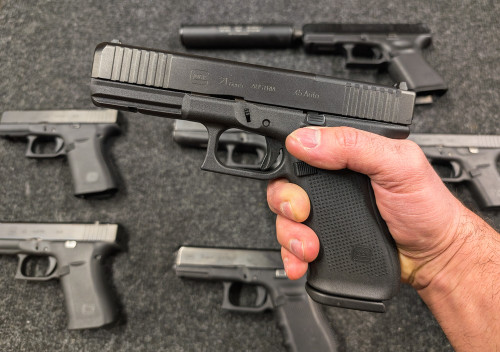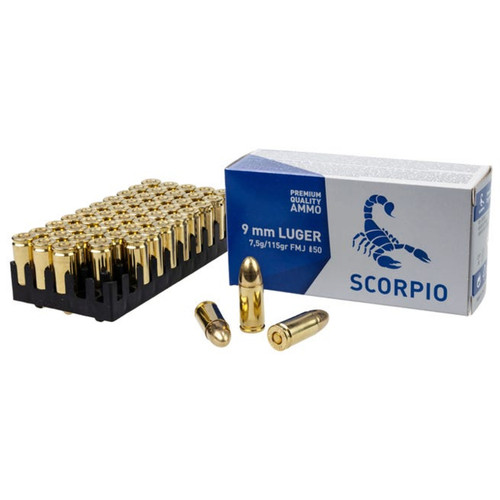The 9x19mm, more commonly known as the 9mm Luger and 9mm Parabellum, is the most widely used centerfire handgun cartridge in the United States. There were more 9mm handguns sold in the United States in 2022 than any other caliber, and they occupy 13 of the top 15 spots on a best-seller’s list. With that many new 9mm guns flooding the market, the demand for 9mm ammo has never been stronger among pistol shooters across the military, law enforcement, and citizenry alike.
While the 9mm Luger has been around for 120-plus years, it’s not the only 9mm cartridge on the block. So, how do you know what’s up to snuff and safe to shoot? The best way is to educate yourself on the subject at hand so you can make your own informed decisions, rather than relying on Internet say-so or gun shop rumors.
Let’s get to know the most famous 9mm cartridge (with an emphasis on the Luger), along with a smattering of other 9mm cartridges on the market today.
The Goldilocks Bullet
Not too hot, and not too cold — or, in the case of the 9mm, it’s neither too big nor too small. When referring to size, there are lots of parameters by which bullets and cartridges are measured, but in this case we’re talking about the diameter of the bullet. Many European manufacturers and designers designate their cartridge metrically, with the bullet diameter preceding the length of the case, both measured in millimeters.
For instance, the 9x19mm NATO features a 9mm-diameter bullet and a case length of 19 millimeters. Not rocket science. American makers buck this nomenclature and stick with our standard units of measurement: the good ol’ inch. A 9x19mm translated to our side of the pond would be something like “.355x.75in ‘Murica.” While that is awesome, it just doesn’t carry the same ring.
It wasn’t a catchy name, however, that made the 9mm the most popular handgun bullet diameter. There are a host of factors that go into ammunition design, chief among them is ease of manufacture. Producing billions upon billions of rounds of ammunition is no small feat, and no government or country is going to reinvent the wheel (or metallic cartridge) each time a military request or market trend arises.
For instance, why do Americans love all things .30-caliber? Partially because dies and machinery for making .30-caliber bullets have existed since the 1800s, when the .30-40 Krag replaced the .45-70 Government as the military’s main service cartridge. Up until 1903, cartridges were named by their projectile caliber followed by the grains of powder used to propel them. The Krag was replaced by the .30-06 (the -06 in reference to 1906, the year in which it was adopted) along with the .30 carbine, and then finally the .308 Winchester. Today’s main service cartridge is the 5.56x45 NATO, for 130-plus years, armories were cranking out .30-caliber ammo in many flavors because that’s the way we’d always done it — and we did a pretty good job.
9mm bullets have followed a similar trajectory since the early 1900s. There’s no shortage of bigger and smaller bullets designed and manufactured before or after this point, but we’re focusing on mainstream, widely adopted cartridges. You don’t have to look hard to find the advantages of using a 9mm bullet.
Big Advantages, Few Tradeoffs
Like anything in life, there are tradeoffs concerning ammo. Want mega knockdown power that’ll flatten a triceratops at 1,000 yards? You’re going to have a monstrously recoiling, eardrum-shattering, shoulder-wrecking beast. Or how about an uber-capacity, micro carrying gun? Physics dictates that the bullets would have to be so small as to be ineffectual for any serious use in this case.
However, the 9mm is an incredibly versatile round that provides a host of advantages. This makes it a very appealing choice for police, military, competitive shooters, and even hunters.
Frontal Area
A diameter of 9mm (or .355”) offers a decent frontal area, which describes the “face” of the bullet as you’re looking at it straight on. This translates to the size of hole it pokes into a target and the amount of smack it’ll deliver.
As an illustration, a flat-nosed .45-70 “punches” harder than, say, a full metal jacket 6.5 Creedmoor. This is because the .45” flat front smacks the target harder than does the 6.5mm, .256” Creedmoor. Imagine getting punched at the same velocity with a baby’s fist, then by Andre the Giant. Which would be more memorable?
Power
Speaking of power, most 9mm ammunition falls between 300 and 500 ft.-lbs. of energy. This is entirely acceptable for self-defense performance as far as military, police, and armed citizens are concerned. In fact, quality 9mm Luger loads such as Hornady’s Critical Defense are widely used by police agencies across the country. The U.S. military has used a 115-grain FMJ load for decades as well.
If you’re concerned regular 9mm Luger isn’t enough, several manufacturers offer +P or +P+ ammo for those who want a bit more punch. The P in +P refers to the pressure at which the cartridge operates. With this increased pressure comes greater velocity, energy, blast, and recoil. Adding another + indicates even higher pressure. However, not all firearms (especially older ones), are rated for +P or +P+ ammo, so know what your gun can handle if you decide to go that route.
Capacity
Most 9mm cartridges also offer generous capacity in magazines. Using two of the most common police sidearms as an example, the 9mm Glock 17 has a magazine capacity of 17 rounds while the .40 Smith & Wesson Glock 22 carries 15 in the mag.
Recoil & Weight
Recoil is another consideration for all shooters. Some manage it better than others, but it is still a consideration nonetheless. The 9mm once again defines what’s “decent” in terms of recoil. It can be modest in a full-size handgun or it can be stout in a micro-handgun.
Also, 9mm ammo is lighter than other popular rounds like the .40 Smith & Wesson or the .45 Auto. Weight makes a difference when you’ve got to carry the gun, ammo, and a spare mag all day.
Bullet Design
9mm projectiles have had more R&D dollars dumped into them than just about any other handgun cartridge. This has yielded scores of terrific bullet designs that negate most perceived disadvantages of the caliber. Because of all the aforementioned advantages, companies and militaries have gone all in on the 9mm (mostly the Luger variety). The result has been the 9mm Luger becoming the gold standard for just about everyone who packs a pistol for any reason other than plinking, although 9mm rounds are great for that, too.
9mm Bullet Design
There are three major categories of bullet design with loads of minor variations. The major categories of bullets are full metal jacket (FMJ), hollow-point/jacketed hollow point (HP/JHP), and soft point (SP). Let’s dive into these to see what you’ll need for your purposes.
FMJ
FMJ is the most ubiquitous and affordable 9mm due to its simple construction, and this ammo is often relegated to training and practice duty. They’re called full metal jacket because the bullet’s lead slug (also called the core) is fully encased in copper. FMJ rounds are known for their excellent reliability because the rounded nose of the bullet feeds easily out of a magazine and into a chamber. FMJ bullets are also what the United States and many militaries use, due to the Hague Convention of 1899 which voted to reduce fatalities by banning the use of hollow points in warfare. While FMJ rounds deliver peak reliability, they leave some terminal performance on the table. When they impact a target, they don’t expand or readily tumble, so they don’t create as much damage as the bullet passes through the target.
HP/JHP
Expansion is the hallmark of the hollow point and jacketed hollow point (the terms are often used interchangeably). The vast majority of defense 9mm bullets are JHP because most have a copper jacket surrounding the exposed lead cavity. HP are all-lead bullets that are most often found in revolver cartridges like the .357 Magnum and .38 Special.
HP/JHP bullets are designed to deliver greater incapacitating power than FMJ. The tip of a hollow point bullet features a cavity that, when meeting a target, fills with material (flesh) and forces the bullet open, expanding the wound channel as the bullet travels through the target. A wider cross section increases the chance that a vital organ will be struck or damaged, ending a threat quicker.
Crossovers
As mentioned before, these aren’t the only three 9mm bullet styles. There are some that blend traits to deliver better feeding and terminal performance while also circumventing some state laws that prohibit JHP ammo.
- Polymer Tip: One such loading is Hornady’s Critical Duty and Critical Defense line of ammo. The bullets feature the shape of an FMJ, but the cavity is filled with a polymer plug that initiates expansion upon impact. This is advantageous over hollow points because some JHP designs can fail to expand due to clothing or other material plugging the cavity, whereas the soft polymer tip of the Hornady FTX bullet is designed to reliably expand under all circumstances.
- Frangible Ammo: Another bullet style that is popular among those who train at close range is frangible ammo. Frangible ammo looks like FMJ but has a thin copper jacket at the tip, but instead of flattening and expanding upon impact, the bullet disintegrates. This greatly reduces ricochets when using steel targets or in indoor shoot houses.
9mm Cartridge Design
Most 9mm ammunition is classified as rimless, centerfire ammunition. It’s called centerfire due to the location of the primer and rimless because the cartridge’s rim doesn’t stick out beyond the body of the case. The primer is easily identifiable as the little circle on the bottom of each loaded round. Inside each primer is a compound that explodes when impacted by a firing pin or hammer, sending a spark through the flash hole, igniting the load of gunpowder.
The case of the cartridge is what contains that gunpowder. It also holds the bullet and primer. It’s most often brass, nickel-plated brass, or steel. Brass is an ideal metal for bullet cartridges because it is relatively malleable compared to other metals. When a primer ignites the charge of gunpowder, the explosion expands the brass, forcing it against the inside of the gun's chamber while the pressure from the gunpowder sends the bullet down the barrel. Expansion of the brass is ideal because it seals the chamber, resulting in cleaner operation and greater velocity of the bullet. This malleability also permits bass cases to be reloaded with ease.
Brass also features a decent degree of lubricity, meaning that it slides off of magazines into a gun's chamber easily. For peak lubricity and corrosion resistance, some manufacturers coat the brass with nickel. This is easily identifiable as a silver coating on the case. Many premium self-defense loads, such as Hornady’s Critical Duty, feature nickel-plated cases.
Steel is another commonly used metal for bullet casings. Steel cased ammo has the benefit of being more affordable than brass, but it has a few drawbacks. First, it can’t be reloaded as easily as brass. Sizing and resizing it can crack the case. Steel also does not expand as well as brass, which can lead to degraded performance and dirtier operation.
Today’s Preferred 9mm Cartridge
The 9mm Luger as we know it today was invented in 1901 by Austrian Georg Luger. Per the Sporting Arms and Ammunition Manufacturers' Institute (SAMMI), the ruling body that standardizes cartridges in the United States, the cartridge’s official designation is the 9mm Luger in honor of its designer. However, the cartridge has other names as well.
In NATO form, the 9mm is given complete metric treatment and is known as the 9x19mm. The 9 refers to the diameter of the projectile, and the 19mm refers to the length of the case. It’s also known as the 9mm Parabellum, which means prepare for war in Latin. No matter what you call it, this 9mm cartridge has a greater following than any centerfire pistol round because of its ideal blend of performance, recoil, cost, and lightweight size.
More 9mm Cartridges You Should Know
America’s appetite for the 9mm Luger has led to a wealth of offerings from established, well-known manufacturers as well as a surge of offerings from new manufacturers, commercial reloaders, and foreign importers. Most of the 9mm that’s commercially available is of acceptable quality. It should function safely and without issue. But there are instances of bad batches of ammo, most frequently the result of lax QC or subpar quality components.
9x18 Makarov
This chubby little Soviet cartridge is well known to those who got to enjoy the golden age of surplus (back when Mosin-Nagant rifles were $69 and crates of 7.62x54R could be had—with or without links!—for a couple hundred bucks). Back then, the 9x18 Makarov and the 7.62x25 Tokarev round were the sidearms of choice for surplus nuts. Both guns fed pistols that shared their name, and the Mak was the less powerful of the duo.
Mak bullets are slightly girthier than the 9mm Luger at 9.27mm, or .365” to the Luger’s .355”. This might seem insignificant, but do not try to load Mak bullets into Luger cases or vice versa.
However, the Mak is less “blasty” when fired, a little less powerful, but still a decent pistol round. Power levels are about 75% of the 9mm Luger, making it a viable-to-marginal choice for self defense by today’s standards. Mak ammo is still being made today by a few manufacturers, including Hornady, which features a 95-grain FTX bullet in its Critical Defense line.
9x23mm Winchester
This is a hot rod 9mm cartridge that excels in IDPA and other go-fast pistol disciplines. Many competitions require that shooters’ ammunition meet minimum power factors but, off-the-shelf, 9mm rarely cuts it for big-time events. Shooters are forced to use higher-power cartridges, such as the 9x23, .38 Super, or .40 S&W.
It has a longer case than the 9mm Luger (22.86mm vs. 19.15mm), giving it greater capacity for gunpowder and therefore more power and blast. It’s a niche caliber with few commercial loadings, most of which are 124- or 125-grain, and almost none that would appeal to folks outside of competitive shooters.
9mm Browning Longs
Here’s a quirky little cartridge that fits nicely between the 9mm Luger and the 9x23mm Winchester. The 9mm Browning Long uses a slightly larger diameter bullet than these at .358”, or 9.09mm. Most 9-based cartridges use the standard .355”-diameter of the Luger, save the Makarov.
As you might guess, the Browning Long was devised by the famous John Moses Browning. Browning’s fertile mind has also given us, most famously, the 1911 pistol, as well as the BAR machine gun, the .50 BMG (Browning Machine Gun) cartridge and associated machine guns, among scads of other designs.
The Browning Long certainly isn’t as enduring as his other designs, but it does pack a zippy punch for a small cartridge. Most loadings are 110 grains or less in the 20mm case, which gives the round velocity at or north of 1,000 fps (but not a lot of wallop).
9x23mm Largo
This one is a relic that goes way back in history, but it’s a cool cartridge nonetheless. It has a slightly longer case length than the 9x23 Winchester at an honest 23mm and is most often found with 124-grain projectiles (when it can be found at all).
Since its introduction in 1901, the Largo (Spanish for long) has been chambered in a number of pistols, carbines, and submachine guns. The Largo is a scorching performer that's right at home in the longer barrel of a carbine or a submachine gun. Longer barrels permit a more complete gunpowder burn, which increases velocity. Shooting high-power cartridges from short barrels often results in tremendous muzzle flash, which is simply gunpowder burned outside of the barrel. Muzzle blast can be impressive, too.
But despite its high cool factor, the Largo enjoys little commercial success these days. Because of this, the ammo is usually quite expensive.
Get 9mm Ammo — In Stock at Pro Armory
9mm ammo has been around for more than a century, and generations of shooters have proven it’s here to stay. If you need a more recent example of its staying power, you need only look at the pandemic of 2020. As Americans panicked and bought all manner of things in preparation for what was described as an apocalyptic outbreak, guns and ammo were among the items bought en masse (second to toilet paper, of course).
With gun store shelves bare across the country, ammo manufacturers dumped all their resources into filling the supply chain with the most popular cartridges. Among them were the .22 LR, .223 Remington, and the 9mm Luger. When supply chain issues are calm and 9mm ammo is more readily available, savvy buyers prefer to buy in bulk to offset the cost of shipping. At Proarmory.com, we have both 1,000-round bulk packs of ammo for training as well as premium self-defense ammo by the box.
No matter what you’re looking for, Pro Armory has a large collection of quality 9mm luger ammo at seriously good prices to keep your guns fed and you smiling.






